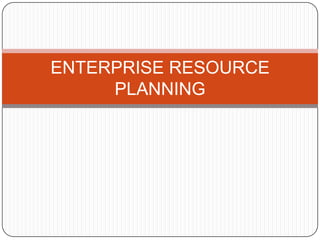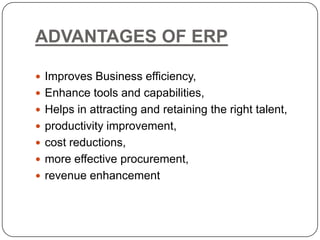Enterprise resource planning
- 1. ENTERPRISE RESOURCE PLANNING
- 2. DEFINITION ’éŚ An accounting oriented information system for identifying and planning the enterprise-wide resources to make,ship and account for customer orders. ’éŚ An enterprise planning system is an integrated computer based application used to manage internal and external resources,including tangible assets,financial resources,material and human resources
- 3. CHARACTERISTICS OF ERP ’éŚ Combines several traditional management function into a logical integrated system and facilitate flow of information across these functions. ’éŚ It is designed to model and automate basic process across the organization over a centralized database. ’éŚ It eliminates the needs of disparate systems maintained by various units of an organization.
- 4. ADVANTAGES OF ERP ’éŚ Improves Business efficiency, ’éŚ Enhance tools and capabilities, ’éŚ Helps in attracting and retaining the right talent, ’éŚ productivity improvement, ’éŚ cost reductions, ’éŚ more effective procurement, ’éŚ revenue enhancement
- 5. ERP-How it can be used to enhance Business enterprise ’éŚ For-- Business integration and improved data accuracy. ’éŚ For-- Planning and MIS ’éŚ For-- improve efficiency and Productivity ’éŚ ForŌĆöEstablishment of standardized procedures ’éŚ By providing Flexibility and Technology
- 6. Ex-PARLE G-ERP MODEL HR STANDAR GENERATE A PLAN D SUBCONTRACTI COSTING RECIEVABLE NGWITH SUPPLIER PURCHASING RAW MATERIAL SHIPPING PRODUCTIO N RECEIVING FINANC MATERIAL E SALES PAYMENT STOCK ISSUE ORDERS Manufacturi SERVICE ng OPTIMIZATIO ORDER N
- 7. ERP process ---PARLE G- Explaination ’éŚ Generating a plan for whole process like what to manufacture,who is a supplier of raw material.how to manufacture ,how to sell,how to keeping stock ’éŚ Contract with suppliers for raw material. ’éŚ Purc hasing raw materials from suppliers ’éŚ Receiving raw materials ’éŚ Make payments to suppliers ’éŚ Start manufacturing-INPUT(R.M)- TRANSFORMATION-OUTPUT(Product) ’éŚ Selling of a product ’éŚ Receive payments then again generate a plan for new product.
- 8. CONCLUSION ’éŚ There must be commitment from all levels. ’éŚ A failed implementation may lead to bankruptcy of an organization.
- 9. RAHJK HD,D V MF EWBDFD









